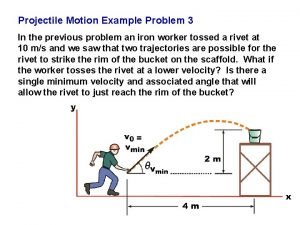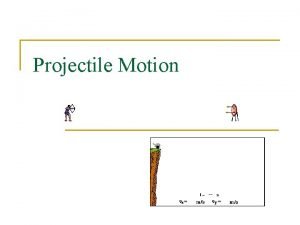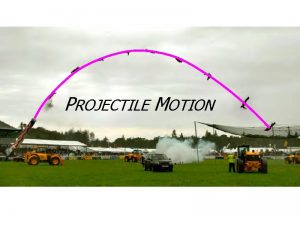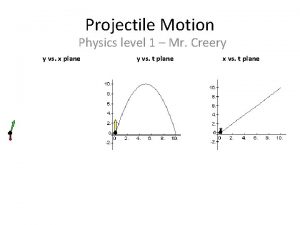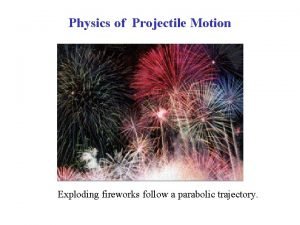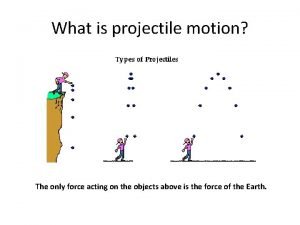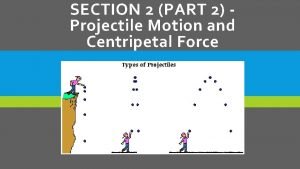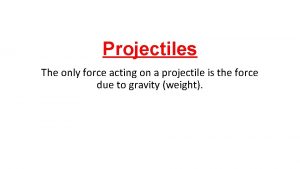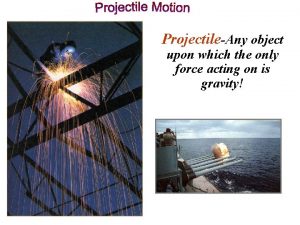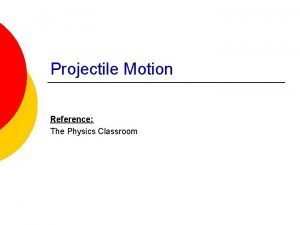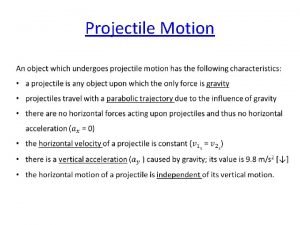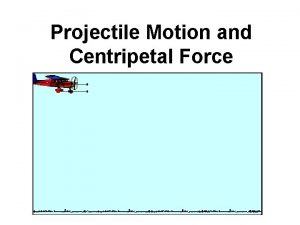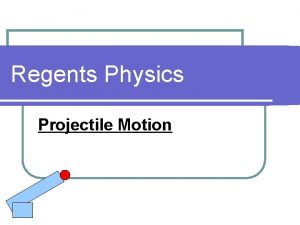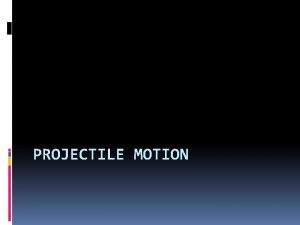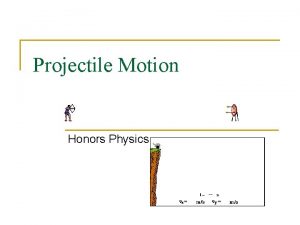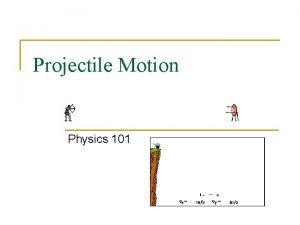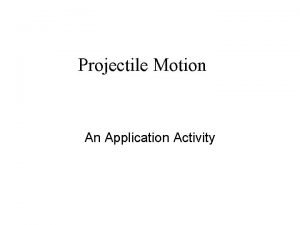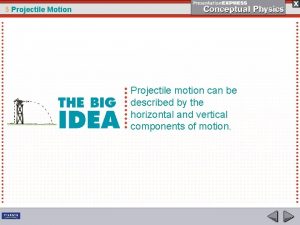More Projectile Motion Discussion Examples More Projectile Motion






















- Slides: 22

More Projectile Motion Discussion: Examples

More Projectile Motion Discussion: Examples I hope this doesn’t apply to you!

Solving Projectile Motion Problems 1. Read the problem carefully, & choose the object(s) you are going to analyze. 2. Sketch a diagram. 3. Choose an origin & a coordinate system. 4. Decide on the time interval; this is the same in both directions, & includes only the time the object is moving with constant acceleration g. 5. Solve for the x and y motions separately. 6. List known & unknown quantities. Remember that vx never changes, & that vy = 0 at the highest point. 7. Plan how you will proceed. Use the appropriate equations; you may have to combine some of them.

Example 4. 4: Non-Symmetric Projectile Motion A stone is thrown! xi = yi = 0 yf = -45. 0 m, vi = 20 m/s, θi = 30º a) Time to hit the ground? b) Speed just before it hits? c) Distance from the base of the building where it lands? Kinematic Equations vxi = vicosθi, vyi = visinθi vxf = vxi , xf = vxi t vyf = vyi - gt yf = vyi t - (½)gt 2 (vyf) 2 = (vyi)2 - 2 gyf

Example 4. 4: Solution A stone is thrown! xi = yi = 0 yf = -45. 0 m, vi = 20 m/s, θi = 30º a) Time to hit the ground? b) Speed just before it hits? c) Distance from the base of the building where it lands? First, calculate vxi = vi cos(θi) = 17. 3 m/s vyi = vi sin(θi) = 10. 0 m/s a) Time to hit the ground? (Time when yf = -45. 0 m) yf = -45 m = vyi t - (½)gt 2 A general quadratic must be solved using the quadratic equation! This gives: t = 4. 22 s Kinematic Equations vxi = vicosθi, vyi = visinθi vxf = vxi , xf = vxi t vyf = vyi - gt yf = vyi t - (½)gt 2 (vyf) 2 = (vyi)2 - 2 gyf

Example 4. 4: Solution A stone is thrown! xi = yi = 0 yf = -45. 0 m, vi = 20 m/s, θi = 30º a) Time to hit the ground? b) Speed just before it hits? c) Distance from the base of the building where it lands? First, calculate vxi = vi cos(θi) = 17. 3 m/s vyi = vi sin(θi) = 10. 0 m/s thit = 4. 22 s b) Velocity just before it hits? vxf = vxi , vyf = vyi – gt so vxf = 17. 3 m/s vyf = 10 – (9. 8)(4. 22) = - 31. 3 m/s Speed (vf)2 = (vxf)2 + (vyf)2 vf = 35. 8 m/s Angle: tan(θf) = (vyf/vxf) = -(31. 3/17. 3) = -1. 8 θf = -60. 9º Kinematic Equations vxi = vicosθi, vyi = visinθi vxf = vxi , xf = vxi t vyf = vyi - gt yf = vyi t - (½)gt 2 (vyf) 2 = (vyi)2 - 2 gyf

Example 4. 4: Solution A stone is thrown! xi = yi = 0 yf = -45. 0 m, vi = 20 m/s, θi = 30º a) Time to hit the ground? b) Speed just before it hits? c) Distance from the base of the building where it lands? First, calculate vxi = vi cos(θi) = 17. 3 m/s vyi = vi sin(θi) = 10. 0 m/s thit = 4. 22 s vf = 35. 8 m/s, θf = -60. 9º c) Distance from the base of th building where it lands? xf = vxi thit = (17. 3)(4. 22) = 73. 0 m Kinematic Equations vxi = vicosθi, vyi = visinθi vxf = vxi , xf = vxi t vyf = vyi - gt yf = vyi t - (½)gt 2 (vyf) 2 = (vyi)2 - 2 gyf

Example 4. 2: The Long Jump A long-jumper leaves the ground at an angle θi = 20° above the horizontal at a speed of vi = 8. 0 m/s. a) How far does he jump in the horizontal direction? (Assume his motion is equivalent to that of a particle. ) b) What is the maximum height reached? Kinematic Equations vxi = vicosθi, vyi = visinθi , vxf = vxi t, vyf = vyi – gt yf = vyi t - (½)gt 2 (vyf) 2 = (vyi)2 - 2 gyf

The Long Jump: Solutions A long-jumper leaves the ground at an angle θi = 20° above the horizontal at a speed of vi = 8. 0 m/s. a) How far does he jump in the horizontal direction? (Assume his motion is equivalent to that of a particle. ) b) What is the maximum height reached? vxi = vi cos(θi) = 7. 5 m/s vyi = vi sin(θi) = 4. 0 m/s a) How far does he jump in the horizontal direction? Range = R = (2 vxivyi/g) = 2(7. 5)(4)/(9. 8) R = 7. 94 m Kinematic Equations vxi = vicosθi, vyi = visinθi , vxf = vxi t, vyf = vyi – gt yf = vyi t - (½)gt 2 (vyf) 2 = (vyi)2 - 2 gyf

The Long Jump: Solutions A long-jumper leaves the ground at an angle θi = 20° above the horizontal at a speed of vi = 8. 0 m/s. a) How far does he jump in the horizontal direction? (Assume his motion is equivalent to that of a particle. ) b) What is the maximum height reached? vxi = vi cos(θi) = 7. 5 m/s vyi = vi sin(θi) = 4. 0 m/s R = 7. 94 m b) What is the maximum height? h = [(vyi)2/(2 g)] h = 0. 72 m Kinematic Equations vxi = vicosθi, vyi = visinθi , vxf = vxi t, vyf = vyi – gt yf = vyi t - (½)gt 2 (vyf) 2 = (vyi)2 - 2 gyf

Example: Driving Off a Cliff!! A movie stunt driver on a motorcycle speeds horizontally off a 50. 0 -m-high cliff. How fast must the motorcycle leave the cliff top to land on level ground below, 90. 0 m from the base of the cliff where the cameras are? Kinematic Equations: vxi = vicosθi, vyi = visinθi , vxf = vxi t vyf = vyi – gt, yf = vyi t - (½)gt 2, (vyf) 2 = (vyi)2 - 2 gyf vxf = vxi = ? vyf = -gt xf = vxft, yf = - (½)gt 2 Time to Bottom: t = √ 2 y/(-g) = 3. 19 s vx 0 = (x/t) = 28. 2 m/s

Solutions: Driving Off a Cliff!! A movie stunt driver on a motorcycle speeds horizontally off a 50. 0 -m-high cliff. How fast must the motorcycle leave the cliff top to land on level ground below, 90. 0 m from the base of the cliff where the cameras are? Kinematic Equations: vxi = vicosθi, vyi = visinθi , vxf = vxi t vyf = vyi – gt, yf = vyi t - (½)gt 2, (vyf) 2 = (vyi)2 - 2 gyf vxf = vxi = ? vyf = -gt xf = vxft, yf = - (½)gt 2 Time to Bottom: t = √ 2 y/(-g) = 3. 19 s vx 0 = (x/t) = 28. 2 m/s vx = vxi = ? , vyf = -gt xf = vxit, yf = - (½)gt 2 Time to the bottom = time when y = - 50 m - (½)gt 2 = - 50 m t = 3. 19 s At that time xf = 90. 0 m So vxi = (xf/t) = (90/3. 19) vxi = 28. 2 m/s

Example: Kicked Football • A football is kicked at an angle θ 0 = 37. 0° with a velocity of 20. 0 m/s, as shown. Calculate: a. The maximum height. b. The time when it hits the ground. c. The total distance traveled in the x direction. d. The velocity at the top. e. The acceleration at the top. θ 0 = 37º, v 0 = 20 m/s vx 0= v 0 cos(θ 0) = 16 m/s, vy 0= v 0 sin(θ 0) = 12 m/s

Conceptual Example vx 0 Demonstration!!

Conceptual Example: Wrong Strategy “Shooting the Monkey”!! Video Clips!!

Example: A Punt! vi = 20 m/s, θi = 37º vxi = vicos(θi) = 16 m/s, vyi= visin(θi) = 12 m/s

Proof that the projectile path is a parabola xf = vxi t , yf = vyi t – (½)g t 2 Note: The same time t enters both equations! Eliminate t to get y as a function of x. Solve the x equation for t: t = xf/vxi Get: yf = vyi (xf/vxi) – (½)g (xf/vxi)2 Or: yf = (vyi /vxi)xf - [(½)g/(vxi)2](xf)2 This is of the form yf = Axf – B(xf)2 A parabola in the x-y plane!!

Example : The Stranded Explorers Problem: An Alaskan rescue plane drops a package of emergency rations to a stranded party of explorers, as shown in the picture. If the plane is traveling horizontally at vi = 42. 0 m/s at a height h = 106 m above the ground, where does the package strike the ground relative to the point at which it is released? vi = 42 m/s h

Problem

Problem Solution Choose the origin at ground level, under where the projectile is launched, & up to be the positive y direction. For the projectile: a. The time to reach the ground is found from the free fall equation, with final height = 0. Choose positive time since the projectile was launched at t = 0. b. The horizontal range is found from the horizontal motion at constant velocity.

c. At the instant just before the particle reaches the ground, the horizontal component of its velocity is the constant The vertical component of velocity is found from: d. The magnitude of the velocity is found from the x and y components calculated in part c. above.

e. The direction of the velocity is so the object is moving f. The maximum height above the cliff top reached by the projectile will occur when the y-velocity is 0, and is found from:
 More more more i want more more more more we praise you
More more more i want more more more more we praise you More more more i want more more more more we praise you
More more more i want more more more more we praise you Aim of simple distillation
Aim of simple distillation Projectile motion tennis
Projectile motion tennis Projectile motion examples
Projectile motion examples Examples of projectile motion in volleyball
Examples of projectile motion in volleyball Illustration of horizontal projectile
Illustration of horizontal projectile Chapter 5 projectile motion exercises
Chapter 5 projectile motion exercises Examples of projectile motion
Examples of projectile motion Percent error formula
Percent error formula Label the projectile
Label the projectile Projectile motion examples
Projectile motion examples Projectile motion ball
Projectile motion ball Only force acting on the projectile is
Only force acting on the projectile is Symmetrical projectile motion
Symmetrical projectile motion Motion map examples
Motion map examples A 14 line lyric poem written in iambic pentameter
A 14 line lyric poem written in iambic pentameter An object in projectile motion will follow which path?
An object in projectile motion will follow which path? The only force acting in a horizontal projectile motion is
The only force acting in a horizontal projectile motion is Object upon which the only force acting is gravity
Object upon which the only force acting is gravity Projectile motion physics classroom
Projectile motion physics classroom Vertical y horizontal
Vertical y horizontal Which describes an object in projectile motion?
Which describes an object in projectile motion?




